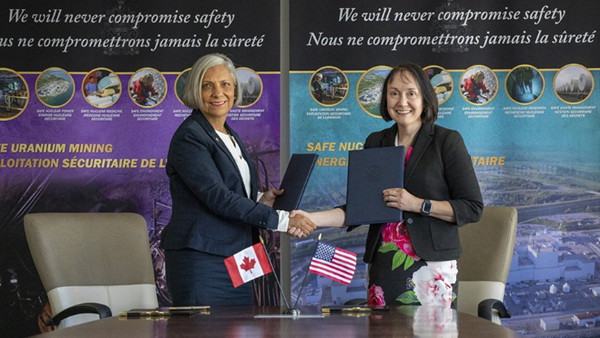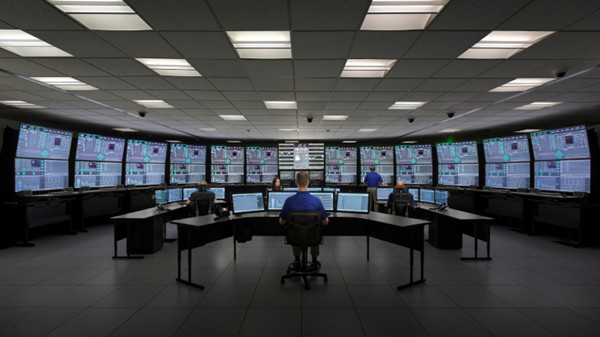Canadian and US nuclear regulators have signed a first-of-a-kind Memorandum of Cooperation (MoC) that will see them collaborate on the technical reviews of advanced reactor and small modular reactor (SMR) technologies. Meanwhile, the US Department of Energy has awarded funds to build SMR simulators at three US universities.

Rumina Velshi (left) and Christine Svinicki at the MoC signing (Image: CNSC)
The MoC was signed on 15 August in Ottawa by Canadian Nuclear Safety Commission (CNSC) President Rumina Velshi and US Nuclear Regulatory Commission (NRC) Chairman Christine Svinicki and follows a Memorandum of Understanding signed two years ago.
"Globally, interest and advances in small modular and advanced reactors are growing rapidly," Velshi said. "The CNSC and the US NRC are working together as regulatory leaders to ensure the development and deployment of these innovative technologies are done safely and efficiently. The signing of this memorandum further strengthens our long-standing history of collaboration with our US counterparts and ensures the effectiveness and efficiency of our regulatory oversight for the future."
Svinicki said the MoC "further shapes our commitment to open and transformative thinking" and enhanced the partners' willingness to work together on matters of advanced nuclear power safety developments while increasing regulatory effectiveness. "Advanced technologies are emerging at a rapid pace, demanding that regulators keep in step with modernisation initiatives and the technologies of the future," she said.
Svinicki and Velshi announced in June that the two agencies would begin exploring enhanced bilateral cooperation through joint regulatory reviews of developing nuclear technologies, to include advanced reactors and SMRs. The MoC is the first of its kind between the two regulators on matters involving nuclear power development.
Advanced reactor and SMR designs incorporate innovative aspects that need to be supported by applicants and reactor vendors with sound scientific and technical evidence, in order to meet regulatory requirements.
Under the MoC, the regulators will work under a previously established steering committee to begin developing the infrastructure needed to share and evaluate cooperative opportunities and best practices in the analysis of advanced reactor and SMR designs.
Both the CNSC and NRC are already carrying out regulatory activities related to proposed SMR projects. The NRC in 2016 accepted for review an early site permit application from the Tennessee Valley Authority for the construction of two or more SMRs at Clinch River, and is conducting a design certification review for NuScale Power's SMR. It is also involved in pre-application reviews for BWXT's mPower and Holtec's SMR-160 designs.
The CNSC has agreements to carry out pre-licensing vendor design reviews for seven SMR and advanced reactor designs, and has completed the first stage of the review process for Terrestrial Energy Inc's Integral Molten Salt Reactor and Ultra Safe Nuclear Corporation's MMR-5 and MMR-10 high-temperature gas reactor. Earlier this year it received its first SMR licence application for a proposal to deploy an MMR plant at Chalk River in Ontario.
Simulator funding
The US DOE has awarded three grants to support the installation of a NuScale reactor plant simulators at Oregon State University, Texas A&M University-College Station and the University of Idaho, NuScale Power announced on 15 August. The simulators will be used for research and educational purposes.

A NuScale SMR simulator at Corvallis, Oregon (Image: NuScale)
"We are very grateful to our university partners for their collaboration and eagerness to participate in this project, and to the Department of Energy for its continued support of NuScale's groundbreaking work in the advanced nuclear industry," NuScale Chairman and CEO John Hopkins said. "These simulator facilities will create new research opportunities and help ensure that we educate future generations about the important role nuclear power and SMR technology will play in attaining a safe, clean and secure energy future for our country."
The simulator facilities will also be used for educational outreach to school-age students and public advocacy regarding nuclear power and SMR technology. The three grants are awarded through the DOE Nuclear Energy University Program and are worth a total of nearly USD844,000.
The simulators are based on NuScale's simulator technology and computer models, and include an interface that accepts input from operators in a virtual control room and displays parameters simulating the plant response. They facilitate research into human factors engineering, human-system interface design, advanced diagnostics, cyber security and plant control room automation. In addition to supporting STEM research and education at universities, NuScale's simulator can be used to show students and members of the public advanced nuclear technology in a control room setting.